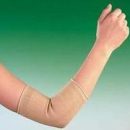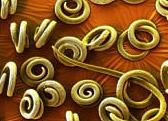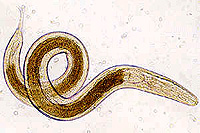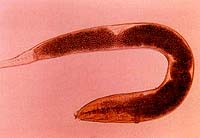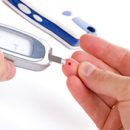Giardiasis is a widespread disease, the flow of which can vary from subclinical to severe. In the body of man and animals, Giardia exist in two forms...
Content
We are located preferably in the upper sections of the small intestine, and when entering the thick intestine, they turn into cysts (dispute shape), which with feces are allocated to the external environment. In wet conditions, in the shade, cysts retain their livelihoods up to 70 days, in the soil – Up to 9–12 days, and with a lack of moisture – 4–5 days.
The main source of infection is a person. However, it has been established that giardias parasitize in the body of cats, dogs, miserable rodents. From a sick child per day with cartoons, up to 900 million cyst pathogen is distinguished, while the infection dose is only 10–100 cyst.
Ways of infection with giardiasis
There are three main transmission paths of giardiasis: water, contact-household and food. Dominates the waterway. Infection occurs most often when using poorly purified tap water or water from open reservoirs. In the case of a contact-household path, infection is carried out through consumers contaminated with cysts: underwear, toys, dishes and t.NS.
In children who have bad habits, such as sucking fingers, pencils, handles, nail biting, almost 100% of cases are detected by Giardia. It is possible to infect with the use of food-infected food.
Entering through the mouth, cysts will be afraid of the barrier of the stomach (their shells are acidpage) and fall into the duodenum, where two vegetative forms are formed from one cyst. Giardia is attached to the mucous membranes of the proximal divisions of the small intestine. Here they adsorb food splitting products.
The consequences of parasitization in the body
Parasitization of giardia in the small intestine is accompanied by a number of pathological effects: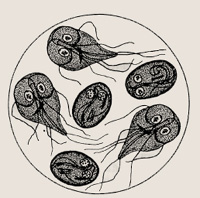
-
The introduction into the mucous membrane of the small intestine causes the development of inflammation in it, which is the result of the cytopathic effects of the productivity of the parasite;
-
As a result of inflammation in the intestine mucous membrane, subatrophic and atrophic changes arise, resulting in damage to the brush border and the development of malabsorption, secondary enzymesopathy;
-
Violation of borya of bile acids is the cause of the skin, disorders of the intestinal motility, dyskinesia of biliary tract;
-
Reducing the synthesis of secretory immunoglobulin A leads to the chronization of inflammatory processes in the gastrointestinal tract;
-
As a result of prolonged persistence of giardia, the effects of their metabolites on the body is formed by chronic endogenous intoxication syndrome, secondary immune failure, organism sensitization.
Most of the patients with giardiasis proceeds in subclinical form. In case of massive invasion, the disease proceeds with severe clinical symptoms and has a sharp or chronic course.
Acute giardiasis occurs more often in young children and is characterized by diarrheal syndrome in the form of a typical acute intestinal infection with a predominant lesion of the small intestine. Dehydration for acute giardial infection is not typical. The disease occurs against the background of normal or subfebrile body temperature. The duration of the process is not more than 5–7 days.
The chronic course of giardiasis is observed mainly in children of preschool age and has a recurrent character.
Symptoms of chronic giardiasis
For chronic form of the disease, the following symptoms are most characteristic: general weakness, fatigue, irritability, decreased appetite, headaches, dizziness, poor sleep, appearance of ticks and hyperkinesov (in the form of bad habits).
Changes in skin:
-
Pallor, especially the skin of the face (with normal hemoglobin figures) and the nose («Marble» White nose skin);
-
uneven skin coloring in combination with its subcomktericity, brownish-icteric skin of the neck, side surfaces of the abdomen, axillary folds;
-
Follicular point keratosis, dry skin, creating the impression of the so-called «Goose skin» with predominant localization on the exclusive surfaces of the hands and legs, the side surfaces of the abdomen;
-
Change coloring and dry skin palms;
-
Defeat of the border of the lips (from light dryness to Haylita);
-
atopic dermatitis.
Other symptoms:
- Persistent tongue.
- Bloating, meteorism, rumbling in the intestines, unstable stool with alternating diarrhea and constipation.
- Abdominal pain during palpation in the right hypochondrium and above navel, at the dots of the gallbladder projection.
- Enlargement of the liver.
- Intestine dysbiosis.
In general blood test in young children, leukocytosis, eosinophilia, monocytosis, anemia, and in older children – leukocytosis, eosinopenia, monocytopenia, slow motion.
Clinical forms of Lamblerosis
Depending on the prevalence of certain symptoms, the following clinical forms of the disease are distinguished: intestinal, hepatobi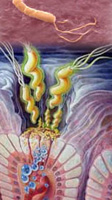 Liar, asthenonevotic, toxico-allergic, anemic and mixed.
Liar, asthenonevotic, toxico-allergic, anemic and mixed.
In case of intestinal form, severe dyspeptic and abdominal syndromes are noted. This is an unstable chair, alternation of constipation and diarrriness, steatheree, malabsorption, moderate abdominal pain, bloating, nausea, loss of body weight, lag in physical development.
For the hepatobiliary shape of the giardiasis characterized by dyskinesia of biliary tract with spasm or atonius of sphincters, cholestasis. Often, the defeat of biliary tract is combined with gastritis, gastroduodenitis, pancreatitis.
In the asthenonevotic form of giardiasis, the symptoms from the gastrointestinal tract are expressed moderately or weakly. Headaches, irritability, fatigue, sleep disorder, neurocirculatory dystonia.
The toxic-allergic form of the disease is characterized by more frequent sharp allergic conditions (urticaria, swelling of quinque). The course of acute allergose with giardiasis stubborn, protracted. He hardly gives up drug therapy. There is often the development of atopic dermatitis, which has a continuous recurrent course. Some patients are damage to the joints.
Diagnostic methods
The most affordable method of laboratory diagnostics of giardiasis in children is a coprological study. However, it should be noted that the cysts of lamblies in feces can not always be detected.
In addition to feces, it is advisable to conduct a study of duodenal content (serving a and b).
For serological diagnostics of giardiasis use the IFA method. Specific antibodies are found in blood through 2–4 weeks after infection. It should be borne in mind that antihlambic antibodies can be found in the blood for another 4–6 weeks after a reservation.
Treatment of giardiasis
Begin treatment of chronic giardiasis from the use of antiparasitic drugs is inappropriate, as this can lead to a pronounced reaction of damage to the occurrence of toxico-allergic complications and exacerbation of clinical symptoms of the disease. Therefore, treatment in such cases should be carried out in 3 stages:
I stage – Elimination of endotoxicosis, mechanical removal of giardia, improved intestinal enzymatic activity, immunological protection correction. Depending on the severity of the symptoms of the disease I, the stage is carried out on the length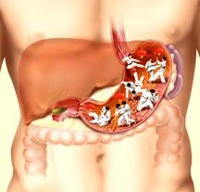 AI 1–2 weeks and includes:
AI 1–2 weeks and includes:
-
a diet that is aimed at creating conditions worsening the reproduction of giardia (cereal, dried fruits, vegetables, vegetable oil); restriction of carbohydrate use;
-
Reception of choleretic drugs, while the advantage is given to Holes and Cholesmolitics;
-
appointment of enterosorbents (silicate, aluminosilicate, organizerineers);
-
enzyme therapy (according to the results of the copron);
-
Antihistamines.
Stage II – Antiparasitic therapy. Today, chemotherapy products from a group of imidazole, tinidazole, as well as nitrofuran-row preparations, are used to treat.
III stage – Increase the protective forces of the body and the creation of conditions that prevent the breeding of giardia in the intestine and the bustling bubble.
For this purpose, a diet, which improves intestinal peristalsis (cereal porridge, vegetable and fruit puree, baked apples, fresh fruits and vegetables, fermented milk products). In order to create a medium that contributes to the destruction of cyst giardies, a decoction of birch kidney is recommended for 2–3 weeks, and after a 2-week break – Reception of the broth seeds of Tolokanyanka for another 2 weeks.
For the correction of the immune response, plant adaptogens are appointed (Echinacea, Eleutherokokk and T. NS.), multivitamin complexes. For the elimination of intestinal dysbiosis, enzymes prescribe probiotics, prebiotics, enzyme preparations. The third stage occupies an average of 2–3 weeks.
Prevention of giardiasis
For the prevention of giardiasis, it is necessary:
-
consumption only filtered tap or boiled water;
-
In closed organized children's groups, examination of children and staff 2 times a year, and when identifying persons who excrete the cysts of the Lamblias, to sanitize all family members;
-
For people who have pets, regularly carry out anthelmintic processing, pills at least once every half a year, cleaning places and animals;
-
remember about the paths of infection and abide by thorough hygiene.
And the main thing to remember that parasitic diseases are not cured with herbs, folk remedies, badges and «Grandma methods» (garlic, for example, annoying the intestines and does not heal the disease, but aggravates).


